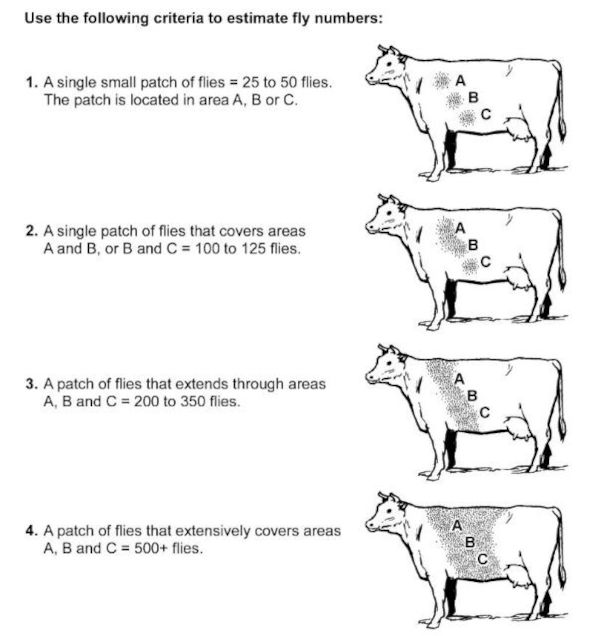By Mark Mauldin
Horn flies are among the most noticeable and serious pests that cattle must endure, particularly through the summer months. At least in part, because the pests are so visible (swarming the withers of a cow, sometimes by the thousands) most cattle producers are quite willing to invest the time and money necessary to control these pests. This willingness is justified. Horn flies can have a real, negative economic impact on a cattle operation. Horn flies feed on blood. With each individual fly piercing its host’s skin 20-30 times a day. When this persistent feeding behavior is multiplied by high numbers of flies the animal experiences pain, irritation, and disruption of normal feeding and resting behaviors; all of which lead to a reduction in performance.
Horn fly. Photo credit: J. F. Butler, University of Florida
There are many effective ways to reduce horn fly populations. Based on my observation the two most common methods used by cattlemen in this area are insecticide ear tags and pour-on products. These products are popular because they are effective, easy to use, and readily available. Unfortunately, there is real concern related to fly populations developing resistance to the insecticides used in these products. Resistance is most likely to develop when ear tags are used. Ear tags are particularly popular because they control flies for an extended period. However, the prolonged interface between the flies and the insecticide increases the likelihood of resistance development.
When resistance develops, entire classes of insecticides become useless. I’ll skip the in-depth explanation of how/why resistance develops and move on to the practical steps you can take to keep it from happening on your operation. That said, there are two factors relating to resistance that you must keep in mind.
- Resistance develops in populations not individuals. A single fly will either live or die when exposed to a given insecticide. A reduction, over time, in the percentage of the population that dies indicates resistance.
- Resistance develops to a specific mode of action (how the insecticide kills), not to specific products.
Practical Steps for Preventing Resistance to Insecticidal Ear Tags
1. Use insecticide ear tags during the peak of fly season when they are needed most.*
2. Use the correct number of tags. Many products call for two tags per cow.
3. Remove old tags as their effectiveness decreases.
4. Do not use tags with the same mode of action more than two consecutive years.
5. Use multiple modes of action in your fly control program.
* Match the time with the highest potential fly numbers to the time when the tags are the most effective – immediately after application. Do not apply tags until the fly population reaches the economic threshold of 200 flies per animal (100 flies per side). See the diagram below for assistance estimating the number of flies present.
Steps 1-3 are all intended to reduce the number of flies that are exposed to a less-than-lethal dose of insecticide. Collectively, these efforts slow the development of resistance within a population to a specific mode of action. Even with these steps in place, there will always be a small portion of any population that will not be susceptible to a specific mode of action (this occurs for a variety of reason, many unrelated to management). Steps 4 and 5 are crucial for controlling those individuals before they generate enough progeny (that are also not susceptible) to appreciably impact a mode of action’s efficacy on the population at large. To effectively rotate modes of action you must understand which mode of action each product uses.

According to the
Veterinary Entomology Pesticide Database there are 16 insecticidal ear tag products, and 50 pour-on/topical products labeled for horn fly control on cattle registered in the state of Florida. The tables below have the products arranged by mode of action.
While there are a considerable number of products available, it is important to notice that there are only three modes of action available. Remember, if resistance is developed all the products utilizing that same mode of action are rendered ineffective for the resistant population, regardless of how the product is delivered (ear tag, pour-on, etc.). To date, resistance has only been documented with pyrethroid products, and only in specific areas. However, care should be taken to prevent more fly populations from becoming resistant to pyrethroids and to protect the efficacy of the other modes of action.
In Florida our “fly season” can be long enough that using more than one horn fly control product may be warranted. This means that it is not uncommon to see multiple pour-on applications, or the combination of ear tags and pour-ons used in the same year. These kinds of scenarios create the opportunity to rotate modes of action in a single season. If more than one fly control product is used in the same season, use at least two different modes of action. For example, if you plan to use a pyrethroid pour-on, use organophosphate tags.
The avermectin pour-on products provide another option in terms of mode of action. However, these products are more valuable to cattle producers as dewormers, and should not be overused just for fly control alone. Utilize these products no more than once a year for fly control, and only when the timing is correct to treat both flies and internal parasites.
Being aware of possible resistance issues and managing accordingly will help to ensure that all the currently available horn fly control products remain viable options for your operation. In addition to the steps described in this article relating to ear tags and pour-on products, there are other fly control products, particularly feed-through IGR (insect growth regulator) products, that can be effective and aid in resistance management.
Source : ufl.edu